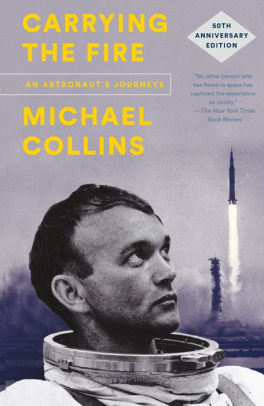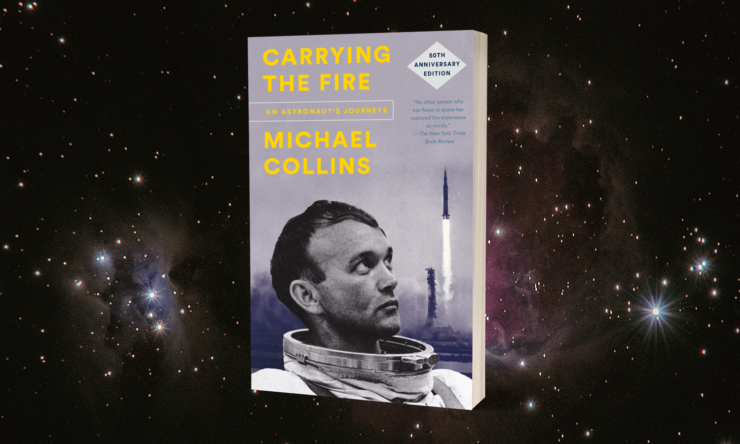There have been many accounts written about the American Apollo Program, which succeeded in placing men (Commander Neil Armstrong and Lunar Module Pilot Buzz Aldrin) on the moon for the first time July 20, 19691. My favourite account is Michael Collins’ 1974 Carrying the Fire: An Astronaut’s Journeys. Collins was the Command Module Pilot. While the Lunar Lander descended to the Moon’s surface, it was Collins’ task to remain with the Command Module in Lunar orbit. Collins is therefore a man who has been within a hundred miles of the Moon without ever touching down on the surface of that world.
Rather than making any attempt at a dispassionate, neutral history of the Apollo Program, Collins provides a very personal account, a Collins-eye view of the American path to the moon. It’s not a short process, which is why it takes 360 pages before Collins and his more well-known companions find themselves strapped into the largest, most powerful man-rated rocket to have been launched as of that date. Before that…
Collins gives the years before his Air Force career comparatively short shrift, perhaps sensing that those early years were not what his audience would most want to read about. Although not as obsessed with flight as other pilots have been, he decided to become a pilot on the grounds that while it was dangerous and promotion could be slow, it was a service not yet populated by his relatives. It was one where he could make own mark. This decision put him on the path to the moon.
In addition to his tour in the Apollo Program, Collins flew for the Gemini Program, a more rudimentary project that collected the operational data needed to prepare for a more ambitious program: sending three living humans to the moon’s surface and back. Collins gives a personal account of his experiences in Gemini 10.
Once page 360 comes around, Collins and his two more famous companions set off for Earth’s natural satellite (Collins was present because a fortuitous medical issue bumped him from Apollo 8 to Apollo 11). I hope it does not come as a surprise to the younger readers to learn that this mission was entirely successful2 .
The text of Carrying the Fire is embellished with black and white photos, as well as Collins’ own hand-drawn diagrams.
Buy the Book


Carrying the Fire: An Astronaut’s Journeys (50th Anniversary Edition)
What makes this work stand out is its voice: Other celebrities without a background in writing often hire ghostwriters to handle the pesky task of producing a readable book. Collins felt ghostwriters were a barrier between the experiences of the person to whom the book was credited and the audience. Refusing to use a ghostwriter was a bold, perhaps even courageous decision. It could very easily have gone horribly wrong. But it didn’t. He wrote a very fine book indeed3.4
Collin’s portrait of NASA isn’t a series of dry paragraphs about technical issues and how they were solved but a frank account of all of the petty office politics, the human factors that shape policy. He and his fellow astronauts aren’t superhuman figures, in the mode approved by the NASA public relations office. There are other accounts of Apollo that go into more technical detail, that provide even more historical minutiae. There are none that are more fun than Collins’ tale of how a fellow who was not markedly ambitious—a pilot whose mechanical skills were such that even he made fun of himself, a guy who did not set out to go to another world—nevertheless found himself orbiting the Moon.
Unsurprisingly, the fiftieth anniversary of Michael Collins’ not landing on the Moon is occasion enough for this venerable classic to see print once more. It can be found at the various links we’ve helpfully provided in this article.
Carrying the Fire is available from Farrar, Strauss & Giroux.
In the words of Wikipedia editor TexasAndroid, prolific book reviewer and perennial Darwin Award nominee James Davis Nicoll is of “questionable notability.” His work has appeared in Publishers Weekly and Romantic Times as well as on his own websites, James Nicoll Reviews and Young People Read Old SFF (where he is assisted by editor Karen Lofstrom and web person Adrienne L. Travis). He is a finalist for the 2019 Best Fan Writer Hugo Award, and is surprisingly flammable.
[1]No one has as yet placed women on the moon. Or anyone transgender or genderfluid.
[2]Although pretty much every Apollo mission had some kind of significant anomaly, from computer issues to lightning strikes, from mid-trip explosions to Alan Bean being unclear on the precise meaning of “under no circumstances point the camera at the sun.”
[3]Collins makes a point of thanking his English teacher, Ferdinand E. Ruge, editor Roger Strauss III, and typist Terry Poetroski, gratitude that seems, if the rest of text is anything to go by, entirely characteristic of Collins.
[4]Dear Mr. Strauss: WHERE IS THE TABLE OF CONTENTS FOR THIS NON-FICTION WORK? AND WHERE IS THE INDEX?











I quite liked this when I read it. That was, alas, decades ago, and I suspect that you and I might have been the only ones who checked it out of the Kitchener Public Library, but my memories of it are fond enough that I might just get this re-issue.
I have a read a lot of astronaut autobiographies and Collins’s is easily the best of them. If you’re interested in what sort of man signed up to Apollo, read Carrying the Fire. (For the record, Tom Stafford’s We Have Capture is a respectable second.)
This was printed when I was about 15. It was one of my favorite books at the time, precisely because of the writing. “I realized that I was lying on top of a ten-story bomb that had been built by the lowest bidder.”
I checked it out of the library when I was in my early teens, sometime in the late 70’s.
Collins is therefore a man who has been within a hundred miles of the Moon without ever touching down on the surface of that world.
I am reminded of the joke that was making the rounds at the time of the 40th anniversary. Neil and Buzz and Mike were picked up at the hotel by a fancy limo and taken to the anniversary celebration. When they arrived, Neil and Buzz walked up the red carpet and into the reception, while Mike had to stay in the limo and drive around the block.
I’m so glad to see this post. I love this book and recommend it to anyone interested in the Apollo project in general and Apollo 11 in particular. Michael Collins is both a good and a thoughtful writer, and also one who doesn’t ignore the details. As someone who grew up in central Massachusetts, I was impressed by his acknowledgement of the seamstresses in Worcester, Mass–employees of Playtex, if I recall correctly–who made sure the seams on the space suits didn’t leak.
There was a story- maybe in More Dangerous Visions- where the Collins character left the others on the Moon and came home.
a very qualified and always overlooked part of the Apollo 11 crew
Well, crap. Collins has died of cancer, aged 90.
https://twitter.com/AstroMCollins/status/1387438495040348168